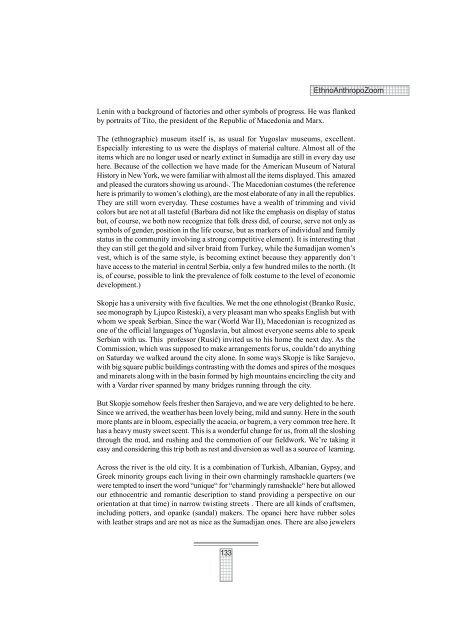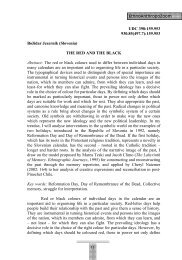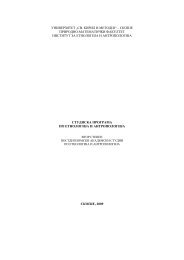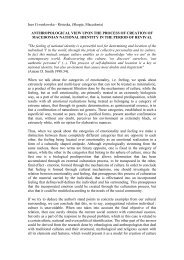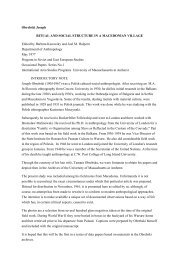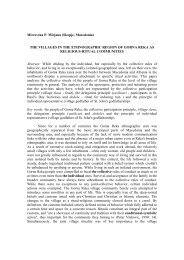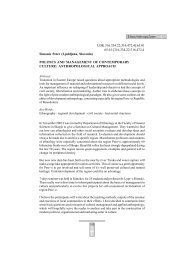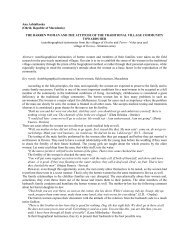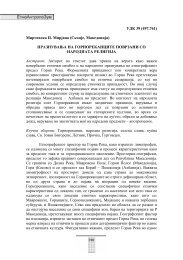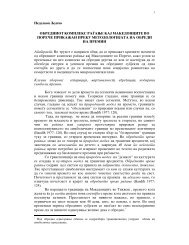Halpern M. Joel, Kerewsky-Halpern Barbara (USA)
Halpern M. Joel, Kerewsky-Halpern Barbara (USA)
Halpern M. Joel, Kerewsky-Halpern Barbara (USA)
Create successful ePaper yourself
Turn your PDF publications into a flip-book with our unique Google optimized e-Paper software.
12345<br />
12345<br />
12345<br />
12345<br />
12345<br />
12345<br />
12345<br />
12345<br />
12345<br />
12345<br />
12345678901234567890123456789012123<br />
12345678901234567890123456789012123<br />
EthnoAnthropoZoom<br />
12345678901234567890123456789012123<br />
12345678901234567890123456789012123<br />
12345678901234567890123456789012123<br />
Lenin with a background of factories and other symbols of progress. He was flanked<br />
by portraits of Tito, the president of the Republic of Macedonia and Marx.<br />
The (ethnographic) museum itself is, as usual for Yugoslav museums, excellent.<br />
Especially interesting to us were the displays of material culture. Almost all of the<br />
items which are no longer used or nearly extinct in {umadija are still in every day use<br />
here. Because of the collection we have made for the American Museum of Natural<br />
History in New York, we were familiar with almost all the items displayed. This amazed<br />
and pleased the curators showing us around-. The Macedonian costumes (the reference<br />
here is primarily to women’s clothing), are the most elaborate of any in all the republics.<br />
They are still worn everyday. These costumes have a wealth of trimming and vivid<br />
colors but are not at all tasteful (<strong>Barbara</strong> did not like the emphasis on display of status<br />
but, of course, we both now recognize that folk dress did, of course, serve not only as<br />
symbols of gender, position in the life course, but as markers of individual and family<br />
status in the community involving a strong competitive element). It is interesting that<br />
they can still get the gold and silver braid from Turkey, while the {umadijan women’s<br />
vest, which is of the same style, is becoming extinct because they apparently don’t<br />
have access to the material in central Serbia, only a few hundred miles to the north. (It<br />
is, of course, possible to link the prevalence of folk costume to the level of economic<br />
development.)<br />
Skopje has a university with five faculties. We met the one ethnologist (Branko Rusic,<br />
see monograph by Ljupco Risteski), a very pleasant man who speaks English but with<br />
whom we speak Serbian. Since the war (World War II), Macedonian is recognized as<br />
one of the official languages of Yugoslavia, but almost everyone seems able to speak<br />
Serbian with us. This professor (Rusi}) invited us to his home the next day. As the<br />
Commission, which was supposed to make arrangements for us, couldn’t do anything<br />
on Saturday we walked around the city alone. In some ways Skopje is like Sarajevo,<br />
with big square public buildings contrasting with the domes and spires of the mosques<br />
and minarets along with in the basin formed by high mountains encircling the city and<br />
with a Vardar river spanned by many bridges running through the city.<br />
But Skopje somehow feels fresher then Sarajevo, and we are very delighted to be here.<br />
Since we arrived, the weather has been lovely being, mild and sunny. Here in the south<br />
more plants are in bloom, especially the acacia, or bagrem, a very common tree here. It<br />
has a heavy musty sweet scent. This is a wonderful change for us, from all the sloshing<br />
through the mud, and rushing and the commotion of our fieldwork. We’re taking it<br />
easy and considering this trip both as rest and diversion as well as a source of learning.<br />
Across the river is the old city. It is a combination of Turkish, Albanian, Gypsy, and<br />
Greek minority groups each living in their own charmingly ramshackle quarters (we<br />
were tempted to insert the word “unique“ for “charmingly ramshackle“ here but allowed<br />
our ethnocentric and romantic description to stand providing a perspective on our<br />
orientation at that time) in narrow twisting streets . There are all kinds of craftsmen,<br />
including potters, and opanke (sandal) makers. The opanci here have rubber soles<br />
with leather straps and are not as nice as the {umadijan ones. There are also jewelers<br />
133<br />
12345<br />
12345


